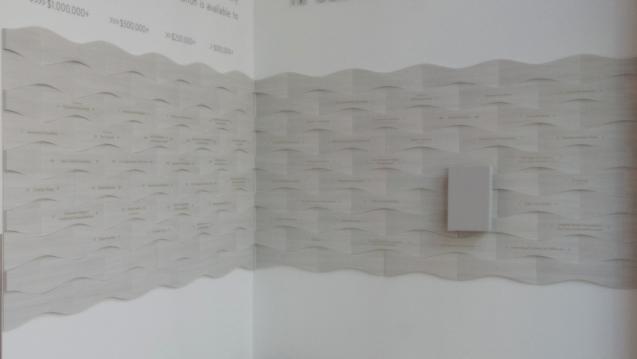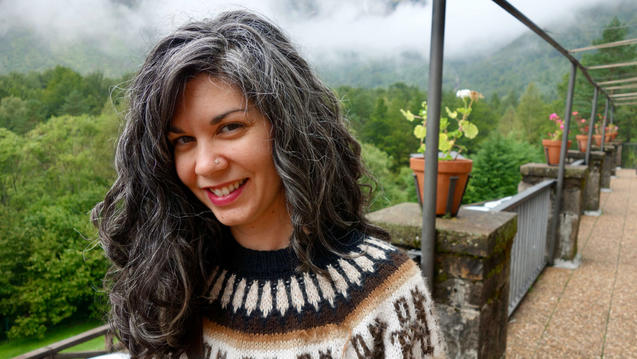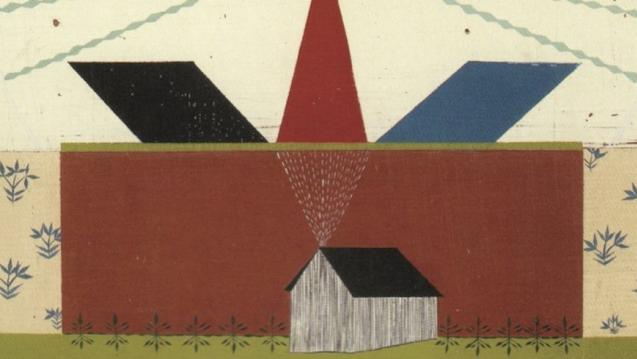Chris Dorosz in Three Dimensions
The first of a two-part interview series celebrating the boundary-defying work of Chris Dorosz
Each has his or her place in the procession
In late June I sat down with artist Chris Dorosz and CIIS graduate students Line Hariri (Integral Counseling Psychology) and Gabriella Stefany (Drama Therapy) to talk about the exhibition entitled Each has his or her place in the procession.
Hariri and Stefany joined us with the hope of understanding Chris’ practice more deeply, specifically interested in how his identities and autobiography inform the selection of media images from which he works, and the grouping of works on view in the gallery. They also shared how their biographies inform their interpretation of the work. The discussion was based on questions developed collaboratively between the interviewers, all of whom have experienced the work regularly over the course of many weeks, starting from the show’s installation.
~
Each has his or her place in the procession is an exhibition peopled by the myriad figures that course between our media landscape and our collective conscious, lodging themselves in a place of memory both eminently recognizable and strange. Carved from foam core, the figures who appear on the wall were originally created as sculptural maquettes for an ongoing series of paintings. When Dorosz started, the photos from which he carved were gleaned from newspapers. Today that seems archaic; they’re pulled instead from online media sources.
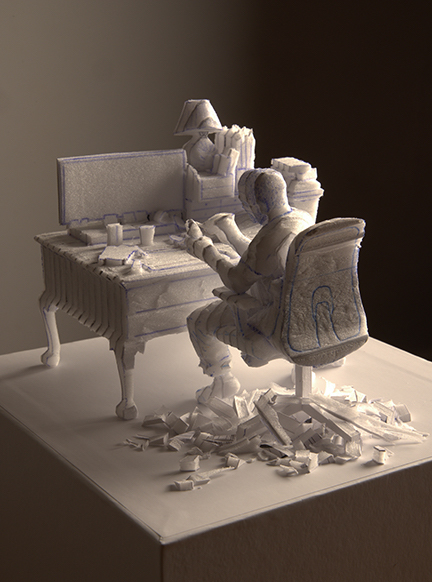
In the gallery, the foam core sculptures are recaptured in photographs, the end point of a dizzying series of transformations from life to two dimensions to 3-D maquettes and back to a photographic print. Scale is similarly transformed; a single sculptural figure presented in the gallery—a self-referential carving of the artist sitting at his desk carving—is the only clue to the viewer that the sculptures captured here in photos are not more than six inches high.
Gazing carefully at the images of these immaculately carved figures, one imagines the exacting practice of creation: each is gestural and perfectly weighted, a figure in motion captured at the speed of photographic exposure. “It comes from the fact that I have Tourette’s syndrome,” shares Dorosz. “One of my ticks is to trace things with my mind's eye.” When the artist was younger and his Tourette’s less controlled, he would “go around and around and around and around an object that [he was] looking at.”
Dorosz has been making these figures for about 15 years and has boxes filled with hundreds of them. Until about five years ago, they were just maquettes made with another end in mind. But then he began to put them—one at a time—in the sunlight and consider what they were. He began to see them as archetypes.
There are practical advantages to sourcing images online, aside from the obvious ubiquity and accessibility. While a newspaper presents only one image of a given scene, the journalistic websites he uses might have five images of the same scene, allowing him to select a different—and perhaps better—pose. Within the frame of the image, Dorosz is most often drawn to the figures who occupy the background.
"I think of myself as sort of a nomad, you know? I’m a monk carving solitarily and I can journey into the world through this computer, but I don’t look specifically for anything. So, you know, I might start with something for my Stasis piece (the original project), but then I give over to the process.
“I think art should pose questions,” Dorosz continues. “At least the art that I wanna do should pose them rather than answer them. I think the ambiguity in the background figures is doing that.”
Another difference between print media and online news images is the feet. Printed newspapers too often cut the figure off, observes Dorosz, leaving out the distribution of weight that is critical for these sculptures. “The weight’s important, and the angle. They’re just this big,” he says, gesturing to about six inches, “and they’re held on the sheet with one pin and if it’s just a little this way, it just doesn’t read right. It looks fake.”
Carving a figure used to take a day. Now Dorosz and his husband are parents to a four-year-old, and the same carving may take “three, four, five days per figure.” He laughs.
"My father was a military guy, but his outlet was cabinetry and carving, so I learned vicariously through him. I never took any formal training, but just sort of looked behind him. And when I needed to get accuracy with my templates in the early days, I figured that, you know, the only way I’m going to figure this out is to do it myself."
It’s important to Dorosz that the work is hand-carved in an age when it could instead be created with a 3-D printer. It’s a question of process and integrity. He reads two lines from the Walt Whitman poem, “I Sing the Body Electric” (Leaves of Grass, 1867) that also gives the exhibition its title:
The curious sympathy one feels, when feeling with the hand the naked meat of the body,
The circling rivers, the breath, and breathing it in and out,
The beauty of the waist, and thence of the hips, and thence downward toward the knees,
The thin red jellies within you, or within me—the bones, and the marrow in the bones…
“So that’s sort of what I’m feeling when I’m carving these things,” Dorosz continues, “Because I’m holding this body and manipulating it. It’s very intimate and there’s nothing sexual about it. It’s sort of like two things: it’s like holding somebody who’s dead, which I have done, and holding a child, which I do.”
The physicality of the body unifies us all, even given differences in circumstance, power, and privilege. “Holding another person that isn’t a lover is very interesting. It opens up human physicality in a very different way.”
When he goes to news sites, Dorosz isn’t looking for anything in particular, and he’s definitely not looking for stories or moments that are traumatic. But our global news sources are filled with stories of crises small and large, whether a heart-rending loss at a sporting event, people displaced by war and its terrible consequences, or those impacted by a natural event like a hurricane. “If I come to something—which is inevitable—I may consider it and, you know, think about how it resonates.” This act of selection intersects with his biography.
"With every show you learn things. And I think the one thing I would have changed in titling it is putting 'ongoing' so that it was underscored that this isn’t a closed narrative. If I could have afforded it, I would’ve printed all 600 figures I have. It’s partly random and it’s instinctive, and of course I’m coming at it from a certain angle."
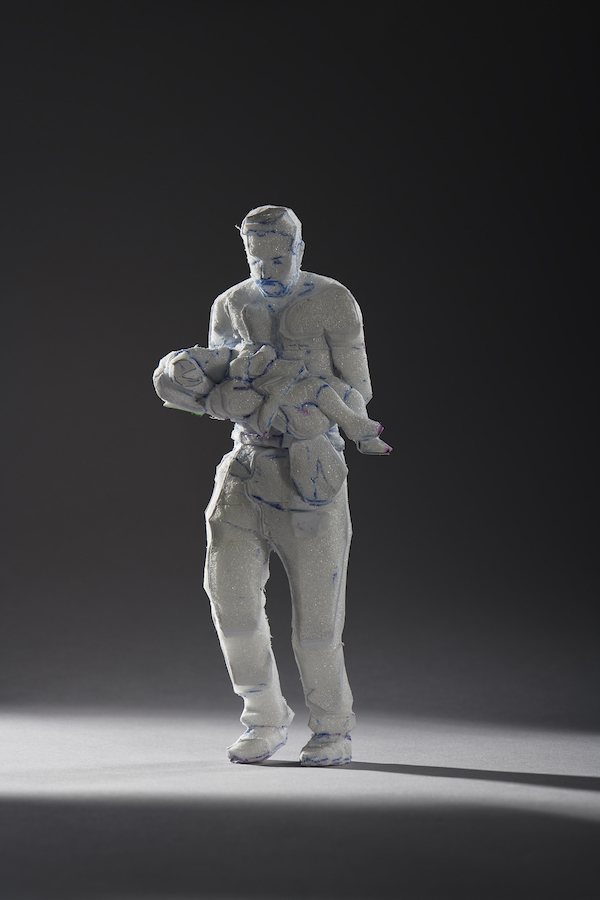
Biography shapes the selection of images that then become sculpture and return again as photos on the wall. As a father, he recognizes a particular love of and curiosity about rendering children. They don’t, the artist notes, have the same limb proportions as adults; this allows Dorosz to render them with just a few strokes. “I also realize that there are quite a few images from the Middle East. My parents lived there, in Cyprus and then Beirut, and I was supposed to be born in Beirut, but the war broke out.” Dorosz’ father was a Canadian peacekeeper then stationed in the Middle East.
"I think I could explain every image here… There’s the politician’s wife. That’s from my coming to grips with American politics as a Canadian. It would have been so easy to put Obama there or Trump, but that would’ve been too constrictive because they hold so much narrative power."
Another thread is time. Present as each figure is in a given moment, over years the symbolic power of the figure shifts. Their meaning isn’t static. “When you look at the titles, you might know some of them and you might not know all of them.” And as you get older, Dorosz observes, “time shifts, and we all go into the ether, like Lot’s wife turning to salt.” For the artist, the difficult element of time appears most personally in the image of the German woman laying a flower at the Dresden Memorial.
"My grandfather was part of D-Day liberation and sort of tangential to the Ukrainian and Polish resistances. And he carried a bullet beside his heart his whole life from World War II. So for me, anything that could potentially reconstruct the narrative around World War II and seeing the enemy, you know, in a new way is complex. Difficult."
The cascade of media imagery is fast and unceasing; yet just for a moment, the careful, evocative, sculptural rendering of a single image in Dorosz’ work slows down our act of viewing. “It’s almost like there's two rivers; one is this glut of imagery that has no meaning necessarily. And then the procession is our natural place with each other.”
He goes on to note that the images rendered from the Middle East are a little different than some of the others. The long history of trauma in the region and the limited and often poor representation of those histories in Western media make their inclusion distinct. “The designer for the catalog put that image—the fourth one there, the man, holding the child—on the cover originally. And I told her to take it off because it just had too much emotional impact.”
Hariri has questions about that same image. “When I looked at your Instagram page, this picture is one that stood out to me, too, the father with the baby. You’d listed it on Instagram as Syrian man holding injured child. When I saw that on the exhibition brochure the title of it is different: Man holding dead child after bombing, Aleppo. What prompted you to change it?”
Dorosz observes that he regularly changes the title, exploring the one that feels most right. That’s why, in fact, he’d like to include “Ongoing” somewhere in the title of the exhibition if he could do it again.
"These are like little poems. I wanted a few less syllables in the first line so decided to remove the word ‘Syrian’ and include a more specific place indicator, ‘Aleppo’, as all the other titles had in the second from last line."
Titling has felt particularly important in this series, and his thoughts continue to shift upon seeing them on the wall. “Which do you prefer?” he asks Hariri, who reflects specifically to the loss of the word Syrian. “It was just described as a man,” Hariri says. “Which takes the context out of the picture. It’s a kind of erasure of a story and something that is ongoing, right? And something that still is a reality for a lot of people and the cause of a humanitarian crisis.”
Dorosz agrees, reflecting on the media context surrounding the war in Syria. “And it’s a cause that’s sort of forgotten. That’s the problem with so much in the media. I mean, the Middle East crisis is still ongoing and we sort of forgot about it for the past couple of years. I struggled with [the piece] Naomi Osaka’s titling, too, because there are so many words. To get across the idea, you have to be really specific. You couldn’t just say ‘Tennis star at the Olympics’ without losing the reference to mental health.”
This debate gets at how much is revealed to the viewer in the title. For Dorosz, referencing mental health would reveal too much, but without Osaka’s name, there is a risk that too much of the meaning of that image would be lost. In the case of the man carrying the child, “I didn’t want the context to be lost; that’s why I included Aleppo, but maybe I’ll put Syria back.”
Hariri’s inquiry also touches on aspects of the work for which there aren’t easy answers, the relationships between media representation, of memory and the specific context of a single event and how it collides with cultural consciousness.
When Hariri first took in the exhibition, she was moved by the delicate touch of the carving, but the intersection of her personal history and consciousness of the erasure of Middle Eastern history in Western media brought an acute meaning to the shift in title. “Then it started to make me think of who this father was, and what was the story. What’s the context, the whole context?”
"I think that your story and where you come from is so important to know for someone who is looking at the art, just because I think identity and all of that informs where your intuition goes or is journeying as you’re creating the argument. That was beautiful for me to hear and to know from you."
~
Chris Dorosz is a Canadian-American artist who divides his time between San Francisco and Winnipeg. He has exhibited across North America in solo exhibitions including the San Jose Institute of Contemporary Art, Mission 17 Gallery in San Francisco, the Canadian Clay and Glass Museum and Plug-In Gallery in Winnipeg. His work has also been featured in numerous group shows, including at the Royal College of Art in Edinburgh, the Southeastern Center for Contemporary Art in Winston-Salem and Mount St. Vincent University Art Gallery in Halifax.
Dorosz has cultivated a hybrid painting-sculpture-photographic practice through which he explores the mutability of the physical world. He is currently a professor at the Academy of Art University in San Francisco where he teaches color theory.
Line Hariri grew up splitting time between the Ivory Coast and Lebanon. The reality of war was always present in both countries, and many family members experienced it directly in Beirut. Hariri is a second year student in Integral Counseling Psychology planning to work in private practice to facilitate POC storytelling groups.
Gabriella Stefany is a child of a Syrian immigrant mother whose family remains in Aleppo. Regular childhood visits became more rare during her early adolescence as what began as a revolution became an ongoing war. Communication with her extended family continues to be hard, as access to reliable technology is difficult. Stefany is in her second year in her master’s program working towards an MFT with a concentration in Drama Therapy.
Deirdre Visser is Curator of The Arts at CIIS. Over twelve years she has created an exhibition program that aims to advance pluralism in contemporary art and dig deep into history as a resource to advance our understanding of the present. In 2019 she was co-curator with Laura Mays of Making a Seat at the Table, which opened that fall at Philadelphia's Center for Art in Wood and featured 43 women and gender non-conforming makers from across North America, and this past March published Joinery, Joists and Gender: A History of Woodworking for the 21st Century (Routledge, 2022).

